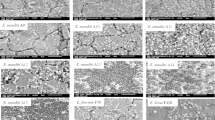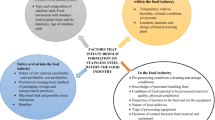Abstract
Pathogenic bacterial biofilms present significant challenges, particularly in food safety and material deterioration. Therefore, using Enterococcus mundtii A2, known for its antagonistic activity against pathogen adhesion, could serve as a novel strategy to reduce pathogenic colonization within the food sector. This study aimed to investigate the biofilm-forming ability of E. mundtii A2, isolated from camel milk, on two widely used stainless steels within the agri-food domain and to assess its anti-adhesive properties against various pathogens, especially on stainless steel 316L. Additionally, investigations into auto-aggregation and co-aggregation were also conducted. Plate count methodologies revealed increased biofilm formation by E. mundtii A2 on 316L, followed by 304L. Scanning electron microscopy (SEM) analysis revealed a dense yet thin biofilm layer, playing a critical role in reducing the adhesion of L. monocytogenes CECT 4032 and Staphylococcus aureus CECT 976, with a significant reduction of ≈ 2 Log CFU/cm2. However, Gram-negative strains, P. aeruginosa ATCC 27853 and E. coli ATCC 25922, exhibit modest adhesion reduction (~ 0.7 Log CFU/cm2). The findings demonstrate the potential of applying E. mundtii A2 biofilms as an effective strategy to reduce the adhesion and propagation of potentially pathogenic bacterial species on stainless steel 316L.



Similar content being viewed by others
References
Liu X, Yao H, Zhao X et al (2023) Biofilm formation and control of foodborne pathogenic bacteria. Molecules 28(6):2432. https://doi.org/10.3390/molecules28062432
Carrascosa C, Raheem D, Ramos F et al (2021) Microbial biofilms in the food industry—a comprehensive review. Int J Environ Res Public Health 18(4):2014. https://doi.org/10.3390/ijerph18042014
Olanbiwoninu AA, Popoola BM (2023) Biofilms and their impact on the food industry. Saudi J Biol Sci 30(2):103523. https://doi.org/10.1016/j.sjbs.2022.103523
Galié S, García-Gutiérrez C, Miguélez EM et al (2018) Biofilms in the food industry: health aspects and control methods. Front Microbiol 9. https://doi.org/10.3389/fmicb.2018.00898
Coughlan LM, Cotter PD, Hill C et al (2016) New weapons to fight old enemies: novel strategies for the (bio)control of bacterial biofilms in the food industry. Front Microbiol 7. https://doi.org/10.3389/fmicb.2016.01641
Dula S, Ajayeoba TA, Ijabadeniyi OA (2021) Bacterial biofilm formation on stainless steel in the food processing environment and its health implications. Folia Microbiol 66(3):293–302. https://doi.org/10.1007/s12223-021-00864-2
Awad TS, Asker D, Hatton BD (2018) Food-safe modification of stainless steel food-processing surfaces to reduce bacterial biofilms. ACS Appl Mater Interf 10(27):22902–22912. https://doi.org/10.1021/acsami.8b03788
Mazaheri T, Cervantes-Huamán BRH, Turitich L et al (2022) Removal of Listeria monocytogenes biofilms on stainless steel surfaces through conventional and alternative cleaning solutions. Int J Food Microbiol 381:109888. https://doi.org/10.1016/j.ijfoodmicro.2022.109888
Khatoon Z, McTiernan CD, Suuronen EJ et al (2018) Bacterial biofilm formation on implantable devices and approaches to its treatment and prevention. Heliyon 4(12):e01067. https://doi.org/10.1016/j.heliyon.2018.e01067
Khalil MA, Alorabi JA, Al-Otaibi LM et al (2022) Antibiotic resistance and biofilm formation in Enterococcus spp. isolated from urinary tract infections. Pathogens 12(1). https://doi.org/10.3390/pathogens12010034
Zanzan M, Ezzaky Y, Achemchem F et al (2023) Optimisation of thermostable exopolysaccharide production from Enterococcus mundtii A2 isolated from camel milk and its structural characterisation. Int Dairy J 147:105718. https://doi.org/10.1016/j.idairyj.2023.105718
Tatsaporn T, Kornkanok K (2020) Using potential lactic acid bacteria biofilms and their compounds to control biofilms of foodborne pathogens. Biotechnol Rep 26:e00477. https://doi.org/10.1016/j.btre.2020.e00477
Vuotto C, Longo F, Donelli G (2014) Probiotics to counteract biofilm-associated infections: promising and conflicting data. Int J Oral Sci 6(4):189–194. https://doi.org/10.1038/ijos.2014.52
Zanzan M, Achemchem F, Hamadi F et al (2023) Anti-adherence activity of monomicrobial and polymicrobial food-derived Enterococcus spp. biofilms against pathogenic bacteria. Curr Microbiol 80(7):216. https://doi.org/10.1007/s00284-023-03326-9
Elidrissi A, Ezzaky Y, Boussif K et al (2023) Isolation and characterization of bioprotective lactic acid bacteria from Moroccan fish and seafood. Braz J Microbiol 54(3):2117–2127. https://doi.org/10.1007/s42770-023-01077-0
Ait Meddour A, Bendali F, Sadoun D (2015) Anti-adherence potential of Enterococcus durans cells and its cell-free supernatant on plastic and stainless steel against foodborne pathogens. Folia Microbiol 60(4):357–363. https://doi.org/10.1007/s12223-014-0367-6
Santos Rosado Castro M, da Silva FM, Kabuki DY et al (2018) Biofilm formation of Enterococcus faecium on stainless steel surfaces: modeling and control by disinfection agents. J Food Process Eng 41(3):e12663. https://doi.org/10.1111/jfpe.12663
Ait Ouali F, Al Kassaa I, Cudennec B et al (2014) Identification of lactobacilli with inhibitory effect on biofilm formation by pathogenic bacteria on stainless steel surfaces. Int J Food Microbiol 191:116–124. https://doi.org/10.1016/j.ijfoodmicro.2014.09.011
Hossain MI, Mizan MFR, Ashrafudoulla M et al (2020) Inhibitory effects of probiotic potential lactic acid bacteria isolated from kimchi against Listeria monocytogenes biofilm on lettuce, stainless-steel surfaces, and MBEC™ biofilm device. LWT 118:108864. https://doi.org/10.1016/j.lwt.2019.108864
Nahle S, El Khoury A, Assaf JC et al (2022) A promising innovative technique for mycotoxin detoxification from beverages using biofilms of lactic acid bacteria. Innov Food Sci Emerg Technol 82:103165. https://doi.org/10.1016/j.ifset.2022.103165
D’Angelo M, Martino GP, Blancato VS et al (2020) Diversity of volatile organic compound production from leucine and citrate in Enterococcus faecium. Appl Microbiol Biotechnol 104(3):1175–1186. https://doi.org/10.1007/s00253-019-10277-4
Morales Estrada A, González Olivares LG, Contreras López E et al (2020) SelA and SelD genes involved in selenium absorption metabolism in lactic acid bacteria isolated from Mexican cheeses. Int Dairy J 103:104629. https://doi.org/10.1016/j.idairyj.2019.104629
Kasimin ME, Shamsuddin S, Molujin AM et al (2022) Enterocin: promising biopreservative produced by Enterococcus sp. microorganisms 10(4):684. https://doi.org/10.3390/microorganisms10040684
Zanzan M, Ezzaky Y, Achemchem F et al (2023) Fermentative optimization and characterization of exopolysaccharides from Enterococcus faecium F58 isolated from traditional fresh goat cheese. Food Sci Biotechnol. https://doi.org/10.1007/s10068-023-01424-9
Jurášková D, Ribeiro SC, Silva CCG (2022) Exopolysaccharides produced by lactic acid bacteria: from biosynthesis to health-promoting properties. Foods 11(2):156. https://doi.org/10.3390/foods11020156
Oleksy-Sobczak M, Klewicka E, Piekarska-Radzik L (2020) Exopolysaccharides production by Lactobacillus rhamnosus strains – optimization of synthesis and extraction conditions. LWT 122:109055. https://doi.org/10.1016/j.lwt.2020.109055
Kravcheniuk K (2018) Characteristic features of Enterococcus faecalis film formation on the stainless steel AISI 321 depending on the surface roughness. Sci Messenger LNUVMB 20(90):58–62. https://doi.org/10.32718/nvlvet9012
Gabriel AA, Ballesteros MLP, Rosario LMD et al (2018) Elimination of Salmonella enterica on common stainless steel food contact surfaces using UV-C and atmospheric pressure plasma jet. Food Control 86:90–100. https://doi.org/10.1016/j.foodcont.2017.11.011
Diaz M, Ladero V, del Rio B et al (2016) Biofilm-forming capacity in biogenic amine-producing bacteria isolated from dairy products. Front Microbiol 7. https://doi.org/10.3389/fmicb.2016.00591
Goh Yong J, Klaenhammer Todd R (2010) Functional roles of aggregation-promoting-like factor in stress tolerance and adherence of Lactobacillus acidophilus NCFM. Appl Environ Microbiol 76(15):5005–5012. https://doi.org/10.1128/AEM.00030-10
García-Almendárez BE, Cann IKO, Martin SE et al (2008) Effect of Lactococcus lactis UQ2 and its bacteriocin on Listeria monocytogenes biofilms. Food Control 19(7):670–680. https://doi.org/10.1016/j.foodcont.2007.07.015
Zhao T, Doyle Michael P, Zhao P (2004) Control of Listeria monocytogenes in a biofilm by competitive-exclusion microorganisms. Appl Environ Microbiol 70(7):3996–4003. https://doi.org/10.1128/AEM.70.7.3996-4003.2004
Winkelströter LK, Tulini FL, De Martinis ECP (2015) Identification of the bacteriocin produced by cheese isolate Lactobacillus paraplantarum FT259 and its potential influence on Listeria monocytogenes biofilm formation. LWT 64(2):586–592. https://doi.org/10.1016/j.lwt.2015.06.014
Gómez NC, Ramiro JMP, Quecan BXV et al (2016) Use of potential probiotic lactic acid bacteria (LAB) biofilms for the control of Listeria monocytogenes, Salmonella Typhimurium, and Escherichia coli O157:H7 biofilms formation. Front Microbiol 7. https://doi.org/10.3389/fmicb.2016.00863
Shokri D, Khorasgani MR, Mohkam M et al (2018) The inhibition effect of lactobacilli against growth and biofilm formation of Pseudomonas aeruginosa. Probiotics Antimicrob Proteins 10(1):34–42. https://doi.org/10.1007/s12602-017-9267-9
Speranza B, Sinigaglia M, Corbo MR (2009) Non starter lactic acid bacteria biofilms: a means to control the growth of Listeria monocytogenes in soft cheese. Food Control 20(11):1063–1067. https://doi.org/10.1016/j.foodcont.2009.01.006
Moradi M, Kousheh SA, Almasi H et al (2020) Postbiotics produced by lactic acid bacteria: the next frontier in food safety. Compr Rev Food Sci Food Saf 19(6):3390–3415. https://doi.org/10.1111/1541-4337.12613
Gogoi A, Poudel M, Sahu J et al (2021) Role of microbial biofilms in agriculture: perspectives on plant and soil health. In: Vaishnav A, Choudhary D K (eds) Microbial polymers: applications and ecological perspectives. Singapore, p 251-288. https://doi.org/10.1007/978-981-16-0045-6_12
Ajijah N, Fiodor A, Pandey AK et al (2023) Plant growth-promoting bacteria (PGPB) with biofilm-forming ability: a multifaceted agent for sustainable agriculture. Diversity 15(1):112. https://doi.org/10.3390/d15010112
Bhatia R, Gulati D, Sethi G (2021) Biofilms and nanoparticles: applications in agriculture. Folia Microbiol 66(2):159–170. https://doi.org/10.1007/s12223-021-00851-7
Pandit A, Adholeya A, Cahill D et al (2020) Microbial biofilms in nature: unlocking their potential for agricultural applications. J Appl Microbiol 129(2):199–211. https://doi.org/10.1111/jam.14609
Kour D, Rana KL, Kaur T et al (2022) Microbial biofilms: functional annotation and potential applications in agriculture and allied sectors. In: Yadav MK, Singh BP (eds) New and future developments in microbial biotechnology and bioengineering: microbial biofilms, pp 283–301. https://doi.org/10.1016/B978-0-444-64279-0.00018-9
Ghiasian M (2022) Microbial biofilms: Beneficial applications for sustainable agriculture. In: Rastegari AA, Yadav AN, Yadav N (eds) New and future developments in microbial biotechnology and bioengineering, pp 145–155. https://doi.org/10.1016/B978-0-12-820526-6.00009-9
Turhan EU, Erginkaya Z, Korukluoğlu M et al (2019) Beneficial biofilm applications in food and agricultural industry. In: Erginkaya Z, Erten H (eds) Malik A. Health and safety aspects of food processing technologies, Cham, pp 445–469. https://doi.org/10.1007/978-3-030-24903-8_15
Funding
The author Mariem Zanzan was the beneficiary of a scholarship from the National Center for Scientific and Technical Research (Grant number 18UIZ2016).
Author information
Authors and Affiliations
Corresponding author
Ethics declarations
Competing interests
The authors declare no competing interests.
Additional information
Responsible Editor: Beatriz Ernestina Cabilio Guth
Publisher’s note
Springer Nature remains neutral with regard to jurisdictional claims in published maps and institutional affiliations.
Rights and permissions
Springer Nature or its licensor (e.g. a society or other partner) holds exclusive rights to this article under a publishing agreement with the author(s) or other rightsholder(s); author self-archiving of the accepted manuscript version of this article is solely governed by the terms of such publishing agreement and applicable law.
About this article
Cite this article
Zanzan, M., Ezzaky, Y., Hamadi, F. et al. Enterococcus mundtii A2 biofilm and its anti-adherence potential against pathogenic microorganisms on stainless steel 316L. Braz J Microbiol (2024). https://doi.org/10.1007/s42770-024-01266-5
Received:
Accepted:
Published:
DOI: https://doi.org/10.1007/s42770-024-01266-5




